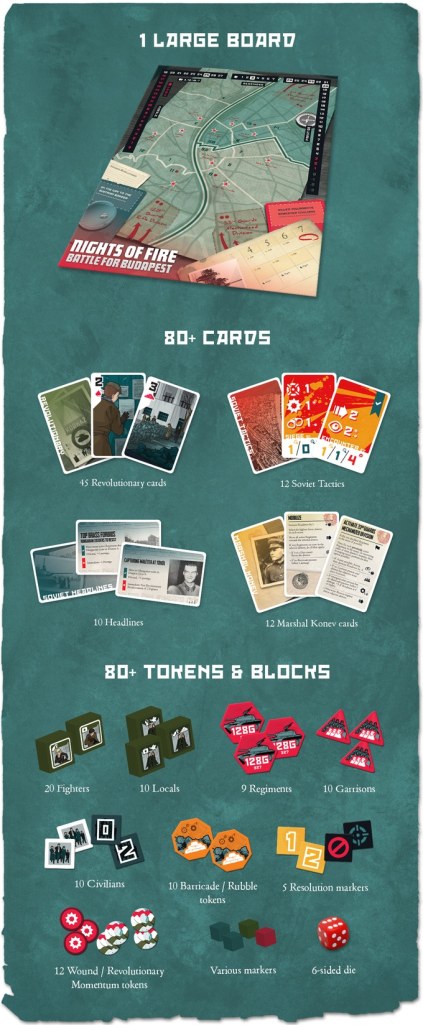IN MANY WAYS I AM A CLASSIC WARGAMER. The first games I played in the late 1970’s were traditional hex & counter with Combat Results Table (CRT) affairs. My wargames usually portrayed the tactical or operational-levels of warfare. In the 40 years since, not only have my interests evolved, but so has the art of wargame design. Nights of Fire: Battle of Budapest (Mighty Boards, 2019) is one of the latest designs to land on my table. The game is a wargame, but a very non-traditional one. It’s probably best to let co-designer Brian Train explain what happened:
During development of this game, David [Turczi] and I batted many mechanisms and processes back and forth. I would say in general terms it steadily evolved away from “numbers-heavy wargame” and towards something we would call “militarized Eurogame.”
Nights of Fire: Battle of Budapest, Designer’s Notes, p. 25
Nights of Fire: Battle of Budapest (NoF) portrays the second week of the conflict (23-30 October 1956). This was the Soviet invasion of Budapest proper. The Soviet player is bent on occupying the city whereas the Revolutionary player must slow down the juggernaut long enough for civilians to escape. NoF externally looks like a hidden-information, area control game. Mechanically under the hood NoF is a card-driven game (CDG) but of a totally different ilk many wargamers may expect. The unique cards are the heart of Nights of Fire and what sets the game apart.

Nights of Fire: Battle Budapest can be played with 1-3 players. In multiplayer versions, one player is the Soviet while the Revolutionary side can be played by up to two players. Unlike so many GMT Games CDG designs, the cards in NoF don’t follow an Event/Operations model. Instead, the Revolutionary player has their own deck of Revolutionary Cards where the cards have an Ops Value and in some cases functional symbols. To execute an action the Revolutionary player must discard ops points. Additionally, to perform certain actions an Insurgent block must be in the District or the player must discard a card with the right symbol. The Soviet player has a deck of Tactics Cards which broadly break down into three categories; Mobile, Encounter, and Siege. Each of these cards has three of eight different symbols giving each card a unique set of abilities. When playing solo, the Soviet player is represented by the Konev AI deck; twelve cards that give present a very challenging opponent.
There are other very Eurogame-type mechanics, like tracking Prestige or Morale which in turn effect the number of cards drawn. The game also has strong narrative elements like fleeing Civilians escaping Arrest or even ones who Defy the Soviets.
As Mr. Train notes:
As I said, I am primarily a wargame designer. David has a background in designing Eurogames, and I can say I learned a lot from him about how wargames can be designed differently.
Nights of Fire: Battle of Budapest, Designer’s Notes, p. 25
In this age of the internet, there are folks out there which will likely balk at mixing Eurogames, with all it’s passive connotations, and militarized together. Too bad. Designers Brian Train and David Turczi have advanced the art of boardgaming with this hybrid wargame-Eurogame design. Wargame players in particular will benefit.
At the recent CONNECTIONS 2019 professional wargaming conference, I saw the continuation of a schism I noted two years back when I attended my first CONNECTIONS. The old grognards, which I am age-wise associated with, seem very reluctant to give up their traditional hex & counter and CRT. There is a very strong “Matrix Games” faction and then there is a smaller group that is pushing the edge of game design by bringing in many Eurogame or other game theory elements to the table. This is where folks like Brian Train excel.
And this is where I want to play my wargames.
Feature image Mighty Boards

One for me to pick up- have you played Brian Train’s earlier Budapest game?
Cheers,
Pete.
I have tried the earlier game. Other B-Train games I’ve tried are enjoyable.
Thank you so much for your kind comments! I’m so glad you like this one, David and I worked very hard on it. David has a talent for introducing suspense and narrative-inducing mechanics.